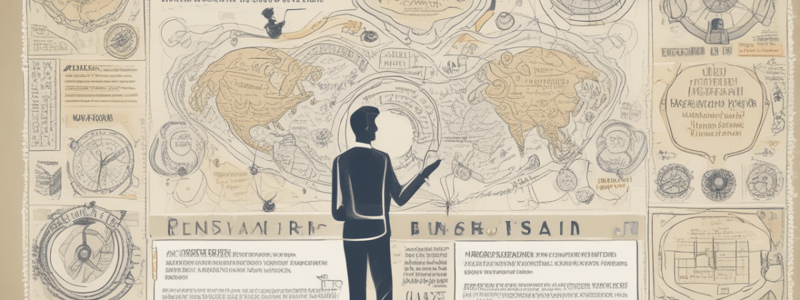Podcast
Questions and Answers
Just in Time (JIT) aims to keep the maximum amount of stock possible in the factory.
Just in Time (JIT) aims to keep the maximum amount of stock possible in the factory.
False (B)
JIT involves buying materials from suppliers who deliver exactly when the materials are needed.
JIT involves buying materials from suppliers who deliver exactly when the materials are needed.
True (A)
Effective quality control can lead to increased costs associated with faulty goods.
Effective quality control can lead to increased costs associated with faulty goods.
False (B)
ISO 9001 is a quality management standard that organizations use to demonstrate their ability to meet customer and regulatory requirements.
ISO 9001 is a quality management standard that organizations use to demonstrate their ability to meet customer and regulatory requirements.
Quality symbols can help businesses increase customer loyalty and satisfaction.
Quality symbols can help businesses increase customer loyalty and satisfaction.
The Q Mark is awarded only to businesses with low standards of quality.
The Q Mark is awarded only to businesses with low standards of quality.
Quality Assurance only refers to the quality of the final product.
Quality Assurance only refers to the quality of the final product.
JIT requires efficient ordering and a steady production process.
JIT requires efficient ordering and a steady production process.
Quality control symbols have no impact on a business's ability to export products.
Quality control symbols have no impact on a business's ability to export products.
High-quality assurances lead to better employee morale and job satisfaction.
High-quality assurances lead to better employee morale and job satisfaction.
Study Notes
Mission Statement
- Serves as a visionary statement outlining a business's identity, purpose, and future direction.
- Provides insights to stakeholders about what drives the business.
- Usually displayed in public areas to express aspirations regarding customer service quality.
- Aids employees in remaining focused on organizational goals.
- Example: Dell’s mission is to be the leading computer firm delivering optimal customer experiences.
Strategic Plan
- A significant long-term framework typically spanning five years or more, developed by the board of directors.
- Guides the business's long-term trajectory and implementation strategies.
- Defines the organization’s purpose while establishing realistic and aligned goals with the mission statement.
- Employs SWOT analysis to assess internal and external strengths and weaknesses.
- Identifies trends and opportunities, leading to informed decision-making about future actions.
- Used for performance measurement and management, allowing for benchmarking and progress tracking.
- Example: An airline's strategic aim using SMART principles might involve capturing 10% of the US market in five years.
Tactical Plans
- Focus on short-term planning, typically covering periods of one to two years.
- Designed to accomplish specific short-term objectives derived from the strategic plan.
- Created by middle management to manage immediate initiatives.
- Examples include aims like increasing sales by 10% within a year or launching an internet shopping platform.
Operational Plans
- Involves immediate short-term planning that addresses day-to-day operational activities.
- Focuses on the practical implementation of tactical plans.
- Developed by departmental managers to manage specific operational tasks.
- Examples include weekly sales forecasts, monthly budgeting, and staff scheduling.
Contingency Plans
- Created to address unforeseen events or emergencies; serve as back-up plans.
- Activated only when original plans are disrupted or no longer applicable.
- Crucial for responding to situations like new competition, equipment breakdowns, or disasters (floods, fires).
- Helps minimize chaos by outlining alternative actions, such as finding new raw material sources during supply disruptions.
Planning Benefits
- Reduces Risk/Uncertainty: Enables identification of potential threats via SWOT analysis and anticipates problems before they arise.
- Future Focused: Encourages a proactive approach toward long-term goals and strategic directions.
- Attracts Investors: Well-structured business plans attract investors, highlighting revenue potentials and business forecasts.
- Improved Communication: Establishes clear channels for communication between management levels, facilitating quick feedback and decision-making.
- Clear Promotional Paths: Provides structured career progression for employees, promoting internal promotions.
- Wider Span of Control: Efficient resource usage increases management's focus on strategic objectives rather than micromanaging.
Disadvantages of Functional/Line Organizational Structure
- Isolation: Departments may develop a sense of separation, impacting collaboration.
- Coordination Difficulties: Focus on individual departmental goals can hinder overall company success.
- Team Disagreements: Internal conflicts within teams can delay project initiation and progress.
- Unclear Chain of Command: Confusion may arise when employees report to multiple leaders, complicating task prioritization.
- Resource Allocation Disagreements: Tensions can emerge over funding between departments, affecting overall organizational efficiency.
- Slower Decision Making: Team dynamics can slow down output due to consensus-seeking.
Product Organizational Structure
- Divides the organization into distinct sections that function like independent businesses.
- Each section is tailored to target specific markets, reporting back to senior management.
- Suitable for companies operating within defined markets, such as Kerry Group with its diverse business areas.
Just in Time (JIT)
- A stock control approach aimed at minimizing inventory levels while ensuring production needs are met.
- Involves timely deliveries from suppliers to match production schedules exactly.
- Requires highly efficient ordering and dependable delivery systems to avoid production disruption.
- Originated in Japan, closely associated with Toyota Motors.
Quality Control
- Involves inspection and assessment to ensure standards are met throughout production processes.
- Effective quality control minimizes costs related to defective products and enhances operational efficiency.
- Achieving quality control certifications (e.g., ISO 9001) indicates a commitment to maintaining high standards.
Quality Mark Symbols
- Serve as trust indicators for consumers that products meet established quality standards.
- Enhance marketability, customer loyalty, and ease of exportation.
- Lead to reduced wastage and increased employee morale through recognition of quality contributions.
Quality Assurance
- A comprehensive system that ensures quality maintenance across all production stages, from design to sales.
- Focuses on sustaining desired quality levels in products and services by monitoring every delivery or production phase.
Studying That Suits You
Use AI to generate personalized quizzes and flashcards to suit your learning preferences.
Related Documents
Description
This quiz explores the essential components of a mission statement for a business. It delves into the purpose, vision, and importance of articulating a clear statement of intent for stakeholders. Test your knowledge on what makes a mission statement effective and how it impacts business operations.




